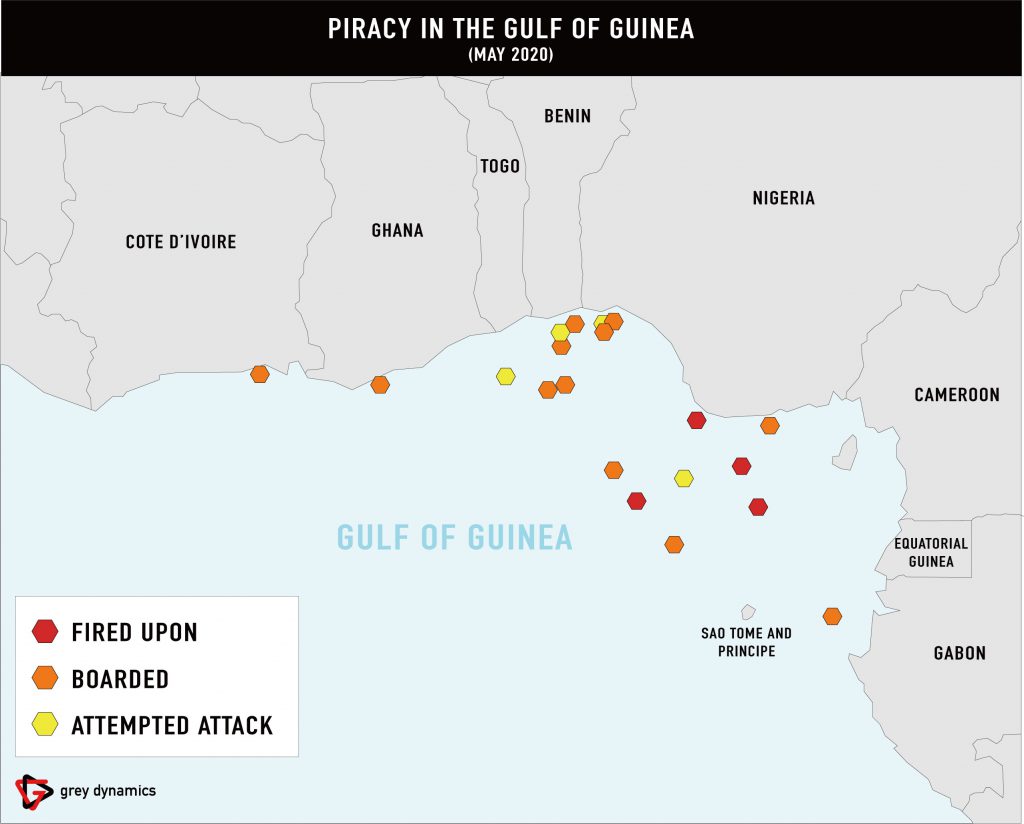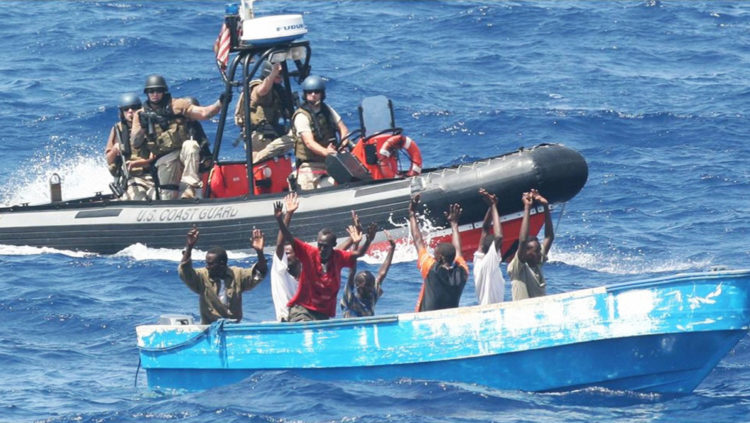Editor’s note: This article was written by Ana-Maria Baloi and originally published on Grey Dynamics.
This report examines the benefits of using satellite imagery in countering piracy activity in the Gulf of Guinea. For collection and processing, the author used Open Source Intelligence (OSINT) and Geointelligence (GEOINT).
The reconstructed scenario is based on the following key judgments:
- KJ-1. Piracy activity in the Gulf of Guinea is on the rise. The number of attacks is highly likely to increase in 2020, due to poor maritime security.
- KJ-2. West African governments concerned with the piracy threat are likely to invest in satellite imagery as a cost-effective instrument for countering illegal activity on their coasts.
- KJ-3. Satellite imagery can successfully track piracy activity in the Gulf of Guinea and serve as a preventive measure for further damages. GEOINT businesses are likely to take over the defense market in West Africa due to efficiency and real-time provided information.
Reconstructed Scenario
In 2019 alone, The International Maritime Bureau’s Piracy Reporting Centre reported 162 incidents of piracy and armed robbery against ships worldwide. This shows a decrease in the number of attacks compared to 201 reported incidents in 2018. While the overall decline in piracy incidents is an encouraging development, vessels remain at risk in several regions, especially the Gulf of Guinea.
It has been more than 10 years since piracy represents a high concern for security along the West African coastline. Although the most known case is that of Somali pirates in East Africa, the Gulf of Guinea has become in recent years a hotspot for piracy and illegal trading. Countries like Nigeria, Cameroon, Togo, and Benin are highly impacted by the piracy threat in their territorial and nearby waters, as their economies depend upon exports. In 2019, national coastguards and polices reported numerous vandalizing attacks, robberies, and kidnappings conducted on small vessels.
Piracy has also fused with organized crime operations. The Gulf of Guinea is primarily known for its opioid smuggling network. In 2018, the amount of tramadol seized in the ports of Nigeria reached 150 tons. The region is accounting for three-quarters of all tramadol seized globally. Wildlife and forestry products are also being trafficked. These include ivory, pangolin scales and rosewood.
Piracy in the area represents a consequence of inefficient governance, weak security forces, illegal activities on land, as well as poverty. While most of the administrations are concerned with the more urgent threat of terrorism and radicalization, maritime threats do not receive much attention.
The Gulf of Guinea – a Hotspot for Piracy
From 2018 to 2019, the number of crew kidnapped in the Gulf of Guinea increased by more than 50%. The cases reported by IBM in the region account for over 90% of global kidnappings at sea. The region accounted for 64 incidents including all four vessel hijackings that occurred in 2019, as well as 10 out of 11 vessels that reported coming under fire.

Maritime-tracking
Although maps and ground photographs offer a clear and broad image of a country or region, remote sensing images are essential tools to detect and record surface conditions and understand changes happening on the landscape, both natural and human-caused.
Despite efforts of regional and international naval forces in the Gulf of Guinea, global piracy continues to threaten key shipping routes. A new solution for the fight against piracy should combine technology (satellite imagery) with human labor (data interpretation).
Already have an account? Sign In
Two ways to continue to read this article.
Subscribe
$1.99
every 4 weeks
- Unlimited access to all articles
- Support independent journalism
- Ad-free reading experience
Subscribe Now
Recurring Monthly. Cancel Anytime.
IMB stresses the need for an information-sharing framework to expedite the receipt and distribution of critical details regarding piracy and armed robbery against ships. This kind of system would give security agencies the ability to assure a safer passage for cargo ships and increase the chances of maritime criminals getting caught.
In Europe, real-time tracking of shipping is about to be implemented across the continent’s waters. EMSAs SafeSeaNet is a vessel traffic program for information covering and monitoring. It functions by tracking Automatic Identification System (AIS) radio signals, an electronic device with which most of the commercial ships are fitted. It broadcasts the ship’s location, heading, and identity. Emerging technologies now enable AIS signals to be received by satellite, allowing for an extended geographical range of the AIS system.
Challenges
There are some challenges that come along with tracking pirates through satellites. The attackers can board a commercial tanker and disable the AIS tracking system, causing the boat to disappear off the radar. However, new technologies such as remote sensory imagery from geostationary satellites in near real-time can help find these missing vessels across square miles of the open ocean.
Apart from this, geospatial intelligence can provide the consumer with detailed information, such as the type of vessel and its documentation number. By identifying typical behaviors and patterns of illegal activities based on statistical analysis provides authorities with starting points, destinations, routes, hot spots where to focus their efforts.
The problem in West Africa is that governments dispose of very limited funds for maritime security. To have access to such information, these countries need to pay private companies owning satellites to provide them with geospatial intelligence. As most of the West African governments are currently concerned with onshore security issues such as radicalism and ethnic violence, the piracy threat is highly likely to remain persistent.
Offshore Data Ensures Onshore Security
While satellite data is providing a valuable resource for tracking vessels on the seas, using high-resolution satellite imaging to monitor the development of ports and land-based maritime assets is another benefit of satellite monitoring application.
Border monitoring, vessel tracking, and patterns of movement in ports can highlight and provide data on any illegal transit. This is particularly important, as the Gulf of Guinea is primarily known for its opioid smuggling network. In 2018, the amount of tramadol seized in the ports of Nigeria reached 150 tons. The region is accounting for three-quarters of all tramadol seized globally. Observing the traffic of goods through ports and customs, via satellite helps to ensure the safe passage of both passenger and cargo boats.
For similar content, you can follow Grey Dynamics on their social media and website.










